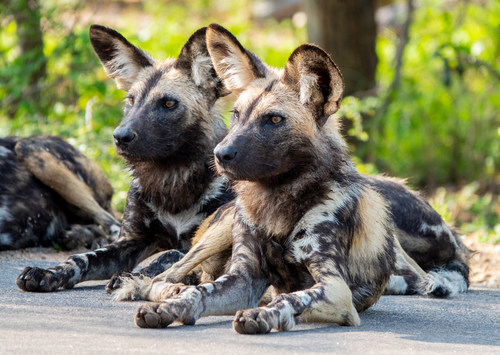
African Wild Dog
Lycaon pictus, the African wild dog, dazzles with its patchwork fur and oversized ears. A master of teamwork, it thrives in tightly-knit packs across Africa's savannas, playing a crucial role in maintaining ecological balance through its coordinated hunting prowess.
10-13 years
Lifespan
17.0 - 36.0 kg
Weight
Length: 75 - 110 cm
Size
Brown, Grey, Red, Black, White, Gold, Tan
Color
12-18 months
Age of Sexual Maturity
3 months
Age of Weaning
45 mph
Top Speed
Endangered
Conservation Status
Decreasing
Population Trend
Characteristics
The African wild dog, Lycaon pictus, is known for its distinctive mottled coat, large rounded ears, and social pack behavior. Inhabiting the savannas and grasslands of sub-Saharan Africa, it is a highly cooperative hunter, relying on teamwork to pursue prey.
Distribution Range of the African Wild Dog
Lycaon pictus, commonly known as the African wild dog or painted wolf, is native to sub-Saharan Africa. Historically, it occupied a range extending from the southern tip of Africa up to Ethiopia, Somalia, and portions of West Africa. Today, the species is primarily found in fragmented pockets across Southern and Eastern Africa, including countries like Botswana, Namibia, Zimbabwe, Mozambique, Tanzania, and South Africa.
African Wild Dog's Habitat
Environmental Conditions
African wild dogs are typically found in savannas, grasslands, open woodlands, and semi-desert areas. They prefer habitats with ample space for hunting and areas where they can avoid human contact. The climate in these regions is often characterized by distinct wet and dry seasons, with temperatures ranging from 20°C to 30°C (68°F to 86°F).
Ecological Niche
Lycaon pictus plays a crucial role as a top predator in its ecosystem, maintaining the balance by preying on medium-sized ungulates such as impalas and gazelles. The species is highly social, living in packs that rely on cooperative hunting strategies. Their presence is indicative of a healthy ecosystem, and they require large home ranges to support their pack's needs, which can vary depending on prey availability and landscape.
Copyright @ Nature Style Limited. All Rights Reserved.
 English
English